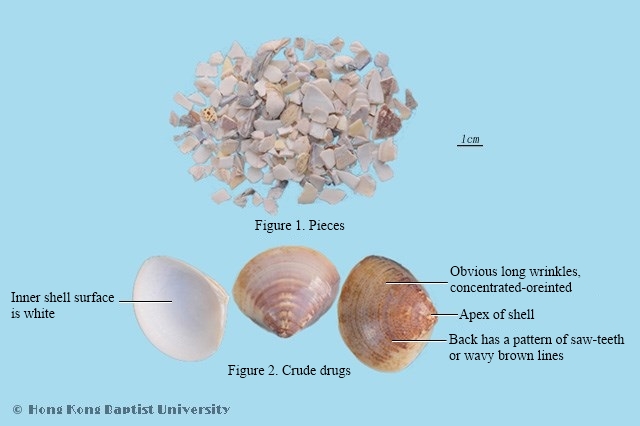Production RegionsPrimarily produced in the Chinese provinces of Hainan, Jiangsu, Fujian, Guangdong.
Macroscopic FeaturesMeretrix meretrix Linnaeus: fan-shaped or semi-spherical, edge of back is slightly triangular, front edge is circular arc, 3~10cm long, 2~8cm tall. Raised apex of shell, located at back side slightly forward. Outer shell surface is smooth, yellowish-brown, with obvious concentric lines; back often has saw-teeth or wavy brown lines. Inner shell is white, without teeth lines on the edge; some front and back shells have a slightly purple color, hinge is relatively wide; right shell has 3 main teeth and 2 front-side teeth; left shell has 3 main teeth and 1 front-side teeth. Firm texture; fractured surface has layered lines. faint odor; tasteless. Cyclina sinensis Gmelin: Sub-spherical, raised apex of shell located at the near central position of back side. Outer shell surface is pale yellow or brown-reddish, raised rib-like lines with a slight concentric arrangement. Inner shell is white or pale red, edge is often slightly purple with neat small teeth-like lines; both sides of hinge have 3 main teeth, without side teeth.
Quality RequirementsSuperior medicinal material has circular arc front edge, firm texture.
PropertiesBitter, salty; cold.
FunctionsClears heat, transforms phlegm, softens hardness, disperses binds, controls acidity, relieves pain. apply to cough due to phlegm and fire, pain of chest and rib, phlegm with blood, scrofula and galls, stomachache with sour regurgitation; externally used to eczema, burns and scalds.
OriginThe dried shell of Meretrix meretrix Linnaeus or Cyclina sinensis Gmelin (Veneridae). Harvest during summer and autumn, removes the flesh, clean, and dry.
